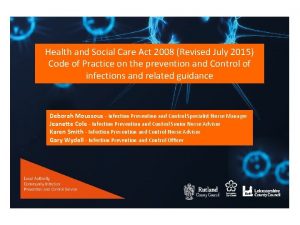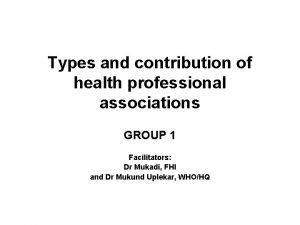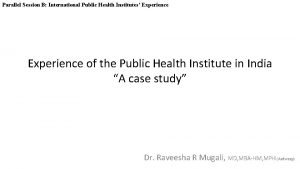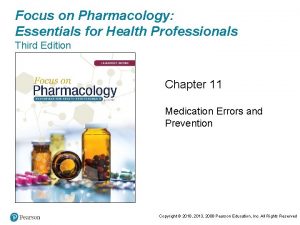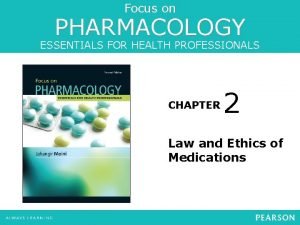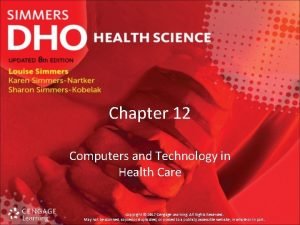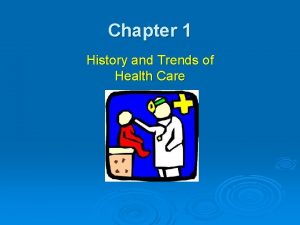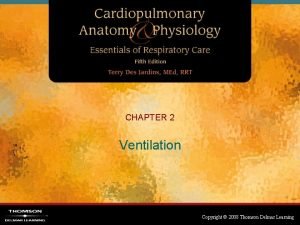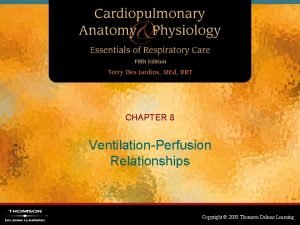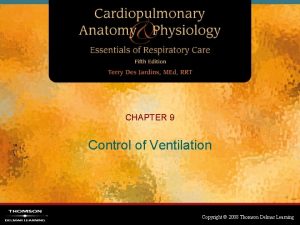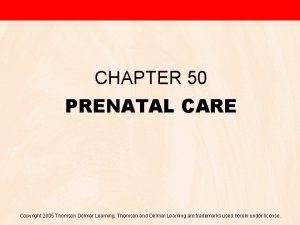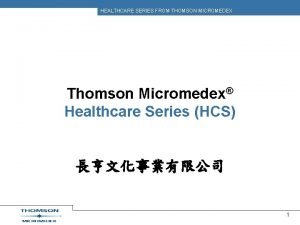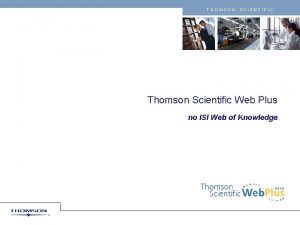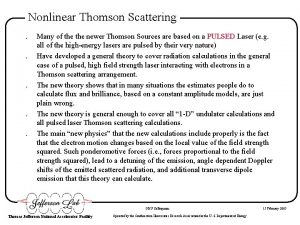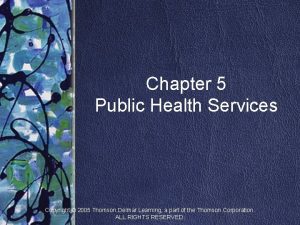Chapter 12 Health Care Professionals Copyright 2008 Thomson






























- Slides: 30

Chapter 12 Health Care Professionals Copyright © 2008 Thomson Delmar Learning

Table 12. 1 Health Care Sector as a Proportion of All Employed Persons, Selected Years 1970 1990 2003 Employment in health sector (thousands) 4, 246 9, 447 13, 615 Total number of persons employed (thousands) 76, 805 117, 914 137, 736 Health sector as a proportion of all occupations 5. 5% 8. 0% 9. 9% Total resident U. S. population (millions) 203. 2 248. 7 290. 8 Number of health personnel per 100, 000 population 2, 090 3, 799 4, 682 2 Copyright © 2008 Thomson Delmar Learning

Factors Contributing to the Increased Supply of Health Care Professionals • • • Technological growth Specialization Health insurance coverage Aging population Emergence of ambulatory clinics Array of post-hospitalization venues 3 Copyright © 2008 Thomson Delmar Learning

Physician Supply • Between 1965 and 2005, there was a 218 percent increase in the supply of active physicians. • In 2005, there were approximately 845, 684 active nonfederal physicians, including osteopaths. 4 Copyright © 2008 Thomson Delmar Learning

Factors Influencing the Supply of Physicians • • • Movement away from managed care Increase in the number of female physicians Lifestyle preferences Population growth Increase in average lifespan 5 Copyright © 2008 Thomson Delmar Learning

International Medical Graduates (IMGs) • By the early 1970 s – IMGs accounted for more than 40 percent of new physician licentiates – 30 percent filled residency positions – 20 percent were active physicians in the United States 6 Copyright © 2008 Thomson Delmar Learning

International Medical Graduates (IMGs) • In 2005, there were 204, 369 IMGs in the United States – Accounted for 24 percent of the total active nonfederal physician population. 7 Copyright © 2008 Thomson Delmar Learning

Factors Contributing to Supply of IMGs • Specialties, geographic locations, and employment settings avoided by U. S. medical graduates. • Surplus of residency positions in teaching hospitals. • Increased market penetration of managed care plans in urban areas. 8 Copyright © 2008 Thomson Delmar Learning

Table 12. 3 Number of Active Physicians and Percentage Distribution by Specialty, Selected Years 1980 2002 Specialty Number Percent Change All 435, 264 100% 768, 498 100% 76. 6% Primary Care 170, 705 39. 2% 286, 294 37. 3% 67. 7% Medical 25, 328 5. 8% 57, 579 7. 5% 127. 3% Surgical 72, 050 16. 6% 104, 871 13. 6% 45. 6% Other 167, 181 38. 4% 319, 754 41. 6% 91. 3% 9 Copyright © 2008 Thomson Delmar Learning

Reference Table 12. 3 • Primary care specialties have grown substantially. • Growth in medical specialties has increased over this period, reaching to more than 120 percent. • Percentage of primary care physicians in any given year has remained fairly constant. 10 Copyright © 2008 Thomson Delmar Learning

Reference Table 12. 3 • Sources of growth in primary care specialties have come from IMGs and women. • In 1980, IMGs constituted 18 percent of all primary care physicians. • In 2003, they accounted for 29. 2 percent. 11 Copyright © 2008 Thomson Delmar Learning

Reference Table 12. 3 • In 1980 – Women constituted 13. 1 percent of all primary care physicians – In 2002, they accounted for 33. 5 percent 12 Copyright © 2008 Thomson Delmar Learning

Geographic Distribution of Physicians • Rural areas and inner-city locations continue to experience physician shortages. • Rural areas with no nearby cities still have fewer than 100 physicians per 100, 000 civilians. 13 Copyright © 2008 Thomson Delmar Learning

Geographic Distribution of Physicians • Nonmetro places with less than 2, 500 inhabitants have experienced no improvement in physician availability in 60 years. 14 Copyright © 2008 Thomson Delmar Learning

Efforts to Improve the Unequal Distribution of Physicians • Federal efforts to improve the distribution of physicians include loan forgiveness and extensive support for the development of family practice training programs. • At the state level, there have been efforts to improve physician distribution through the authority of Offices of Rural Health. 15 Copyright © 2008 Thomson Delmar Learning

Osteopathy • Osteopaths traditionally emphasize the importance of the musculoskeletal system on general health. • Osteopaths are licensed to practice medicine and perform surgery in all states. • In 2005, there was a total of 50, 532 osteopaths in the Unites States. 16 Copyright © 2008 Thomson Delmar Learning

Dentists • Majority of dentists are in general practice. • Approximately, 14 percent of all dentists are specialists. • Orthodontists comprise roughly 33 percent of all dental specialists. • Oral surgeons constitute 25 percent of the specialist population. 17 Copyright © 2008 Thomson Delmar Learning

Table 12. 5 Total and Active Dentists and Dentist/Population Ratios: Selected Years Number of Dentists Year Total Active Total Population (Thousands) Active Dentists per 100, 000 population 1960 105, 200 90, 120 182, 287 49. 4 1980 147, 280 126, 240 228, 831 55. 2 168, 000 276, 740 60. 7 2000 18 Copyright © 2008 Thomson Delmar Learning

Reference Table 12. 5 • In 2000 – Approximately 168, 000 active dentists practicing in the United States. • The earlier increases in the number of dentists can be attributed to federal legislation passed in the early 1960 s and 1970 s that attempted to remedy the perceived shortage. 19 Copyright © 2008 Thomson Delmar Learning

Reference Table 12. 5 • Between 2000 -2001 – There were 55 dental schools and 4, 327 firstyear dental students in the United States. 20 Copyright © 2008 Thomson Delmar Learning

Public Health Professionals • Administration of health agencies • Planning and evaluating prevention, screening, and health education programs • Surveillance and control of environmental hazards and pollutants • Incidence and prevalence of disease in populations 21 Copyright © 2008 Thomson Delmar Learning

New Roles for Public Health Professionals • Role in managed care – Monitor disease incidence – Prevalence and outcome – Develop, implement, and monitor programs of prevention • Bioterrorism surveillance and prevention 22 Copyright © 2008 Thomson Delmar Learning

Nurses • RNs are the largest group of licensed health care professionals in the United States. • In 2000, an estimated 81. 7 percent of RNs were employed in nursing. • Despite an overall increase in the number of nurses employed in nursing, a shortage still exists. 23 Copyright © 2008 Thomson Delmar Learning

Factors Contributing to the Nursing Shortage • • • Decline in nursing school enrollments Aging of the RN workforce Nurses not employed in nursing Decline in relative earnings Emergence of alternative job opportunities 24 Copyright © 2008 Thomson Delmar Learning

Pharmacists • In the 1980 s and 1990 s – Pharmacists expanded their role to include drug production education and to act as experts on the effects of specific drugs, drug interactions, and generic drug substitutions. 25 Copyright © 2008 Thomson Delmar Learning

Pharmacists • In the early twenty-first century – Role was further expanded to include selecting, monitoring, and evaluating appropriate drug regimens – Providing information to patients and health care professionals – Preventing medication errors 26 Copyright © 2008 Thomson Delmar Learning

Physicians’ Assistants • Qualified by academic and practical training to provide patient services under supervision of a licensed physician. • May diagnose, manage, and treat common illnesses, provide preventive services, and respond to emergency situations. • May prescribe certain classes of medications. 27 Copyright © 2008 Thomson Delmar Learning

Advanced Practice Nurses • • • Basic nursing education Basic licensure Graduate degree in nursing Experience in a specialized area Professional certification from a national certifying body • An APN license, if required 28 Copyright © 2008 Thomson Delmar Learning

Seven Core Competencies • Direct clinical practice • Expert guidance and coaching of patients, families, and other care providers • Consultation • Research skills • Clinical and professional leadership • Collaboration • Ethical decision-making skills 29 Copyright © 2008 Thomson Delmar Learning

Issues in PA and NP Use • Legal restrictions concerning practice • Reimbursement policies • Relationships with physicians 30 Copyright © 2008 Thomson Delmar Learning
 Health and social care act 2008
Health and social care act 2008 Health and safety social care act 2008
Health and safety social care act 2008 2008 2008
2008 2008 Copyright 2008
Copyright 2008 Copyright 2008
Copyright 2008 Copyright 2008
Copyright 2008 Copyright 2008
Copyright 2008 2008 pearson prentice hall inc
2008 pearson prentice hall inc Copyright 2008
Copyright 2008 Copyright 2008
Copyright 2008 Types of health professionals
Types of health professionals Health professionals follow-up study
Health professionals follow-up study Allied medical professionals list
Allied medical professionals list Allied health professionals
Allied health professionals Objective for solid waste management
Objective for solid waste management Hosa – future health professionals
Hosa – future health professionals Focus on pharmacology essentials for health professionals
Focus on pharmacology essentials for health professionals Lomotib
Lomotib Primary secondary tertiary care definition
Primary secondary tertiary care definition Unit 2 equality diversity and rights
Unit 2 equality diversity and rights Health and social component 3
Health and social component 3 Chapter 3 careers in health care review questions
Chapter 3 careers in health care review questions Chapter 3 career in health care
Chapter 3 career in health care Chapter 12 computer technology in health care
Chapter 12 computer technology in health care Test chapter 1 history and trends of health care
Test chapter 1 history and trends of health care Chapter 2 health care systems
Chapter 2 health care systems Health care agencies introduction
Health care agencies introduction Chapter 1 history and trends of healthcare
Chapter 1 history and trends of healthcare Chapter 13 diversity and difference in health care
Chapter 13 diversity and difference in health care Chapter 3 careers in health care
Chapter 3 careers in health care Chapter 3 health wellness and health disparities
Chapter 3 health wellness and health disparities
